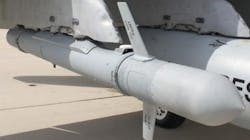Navy picks Jopana to provide airborne electronic warfare (EW; embedded computing and data storage from GMS
RIDGECREST, Calif. – Airborne electronic warfare (EW) experts at Jopana Technologies Inc. in Oxnard, Calif., will provide the U.S. Marine Corps with EW capability for fixed-wing aircraft, helicopters, and unmanned aerial vehicles under terms of an $11.5 million five-year contract announced Monday.
Officials of the The Naval Air Warfare Center Weapons Division at China Lake Naval Weapons Station in Ridgecrest, Calif., are asking Jopana to provide AN/ALQ-231(V) Intrepid Tiger (IT II) family of systems hardware and incidental engineering services.
The Intrepid Tiger II EW pod and embedded computing subsystem provides airborne electronic warfare and electronic attack communications jamming capability for Marine Corps fixed-wing aircraft, helicopters, UAVs, ground-based systems, and laboratories.
In 2012 Navy officials designated the AN/ALQ-231(V) Intrepid Tiger II as a rapid deployment capability to provide critical airborne electronic attack capability to ground forces quickly, Navy officials say.
General Micro Systems Inc. (GMS) in Rancho Cucamonga, Calif., provides the company's S902R Golden-Eye III and S905R Raider III rugged processor and data storage systems for the AN/ALQ-231(V).
GMS is the original source of the system's rugged general-purpose processors, and is the only company that can provide processors and components without a substantial duplication of cost to the government, Navy officials say.
The GMS Golden-Eye III is designed to provide rugged embedded computing for defense and UAV applications, as well as industrial and commercial applications, GMS officials say. It is widely deployed in Army vehicles, robots, and UAVs, and works with the Windows 7, Linux, and VxWorks operating systems.
The S902R Golden-Eye III small lightweight computer is conduction cooled and sealed, and operates in temperatures from -40 to 85 degrees Celsius without throttling, GMS officials say. The computer is based on the Intel i7 Core processor with as many as four physical CPU cores, as much as 16 gigabytes of SDRAM.
Related: Electronic warfare technology heading-up the battlefield
The S902R supports as many as five Gigabit Ethernet channels with TCP/IP offloading engine, six USB 2.0 ports, as many as four removable 2.5-inch solid-state drives, eight buffered digital I/O lines, dual video, four COM ports with RS232/422/485 options, and an audio headset jack with a one-watt audio amplifier to drive an 8-ohm speaker.
The Golden-Eye computer measures 5.38 by 6.88 by 2.13 inches, weighs 3.25 pounds, and consumes as little as 25 Watts of power.
The GMS S905R Raider III also is a rugged computer for defense and UAV applications that is designed for applications where a rugged computer is needed to provide the best possible performance per dollar per Watt, GMS officials say.
Related: Rugged embedded computer to speed design of SDR/ EW systems introduced by Curtiss-Wright
The Raider III supports the Intel i7 Core processor,and runs on the CANbus and MIL-STD-1553 databuses. Like its Golden-Eye cousin, it operates in temperatures from -40 to 85 C. It is a fanless system that can be mounted directly to a metal surface or be used as a stand-alone system. It measures 5.5 by 5.5 by 1.24 inches, weighs 1.9 pounds, and runs on as little as 25 Watts of power.
Jopana specializes in laboratory-based special test and data acquisition/reduction equipment for weapon system analysis. Jopana has experience in providing custom test equipment and data processing equipment for a variety of military aircraft, including the F-14, F-117, and F/A-18 aircraft, as well as the AIM-9, AIM-7, AIM-54, AIM-120, and SM-2 missiles.
On this contract Jopana will do the work in Oxnard, Point Mugu, and China Lake, Calif., and Yuma, Ariz., and should be finished by October 2024. For more information contact Jopana Technologies online at http://jopana.com, General Micro Systems at www.gms4sbc.com, or the Naval Air Warfare Center Weapons Division at www.navair.navy.mil/nawcwd.
